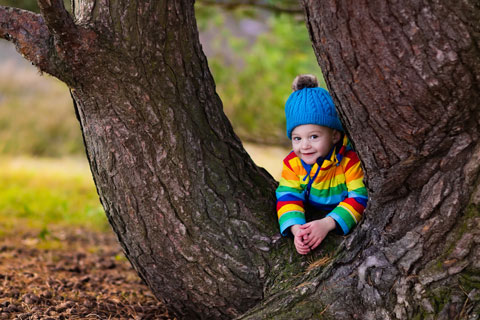You don’t have to go to exotic places to find interesting plants and animals to study at home or in the classroom! Illinois is home to a wide variety of trees that are as close as your local park or schoolyard.
Start by drawing children’s attention to some of the trees around them.
- Ask them to look at trees from a distance and up close. What are some things they notice? Introduce tree-related words such as bark, trunk, branch, leaf, needle, twig, and roots.
- Invite children to draw or paint pictures of their experiences with trees. Encourage them to tell the stories that go with their pictures.
- Ask, “What are some things you know about trees?” “How can a person tell that something is a tree?” “What is the difference between a tree and a bush?”
- Bring in a local expert to answer children’s questions about trees. You might try a botanist, an arborist, or a master naturalist. It helps to have the children rehearse their questions before the visit. Record the answers on chart paper and display them in the classroom.
Collect resources about trees.
- Ask a librarian to help you find nonfiction picture books, nature magazines, and online resources with detailed illustrations of trees.
- Display posters of trees in the classroom. Add laminated pictures of trees to the science center.
- Contact your local school district or wildlife center for additional resources (e.g., coloring sheets, bark samples).
Visit nearby trees during different seasons.
- Take along field guides, magnifiers, and drawing materials. At any time of year, give children bags for collecting specimens: leaves and nuts during autumn, twigs and evergreen needles in winter, blossoms during spring, and seeds or fruits during summer. If some children do not enjoy touching these items, allow them to use tongs or work with a peer. Display the items you have collected on a tray in the science center.
- Have children take photos and make sketches of two to three trees once a month. They can make a book that shows how the trees change over time. Draw attention to details such as the amount and colors of leaves on the trees, especially during autumn.
- Use a field guide or an educational poster to identify trees. Point out differences in leaves, needles, seeds, and bark patterns. Show the children how to make bark rubbings or leaf rubbings.
- Provide measuring tapes and non-standard measures such as unit blocks or lengths of clothes line. Let children measure the trunks, leaves, and other parts of trees.
- Call children’s attention to other living things in or near a tree such as birds, insects, or squirrels. Help them keep a list of the creatures they find.
IEL Resource
- Resource List: Appreciating the Natural World with Young Children


 PDF
PDF